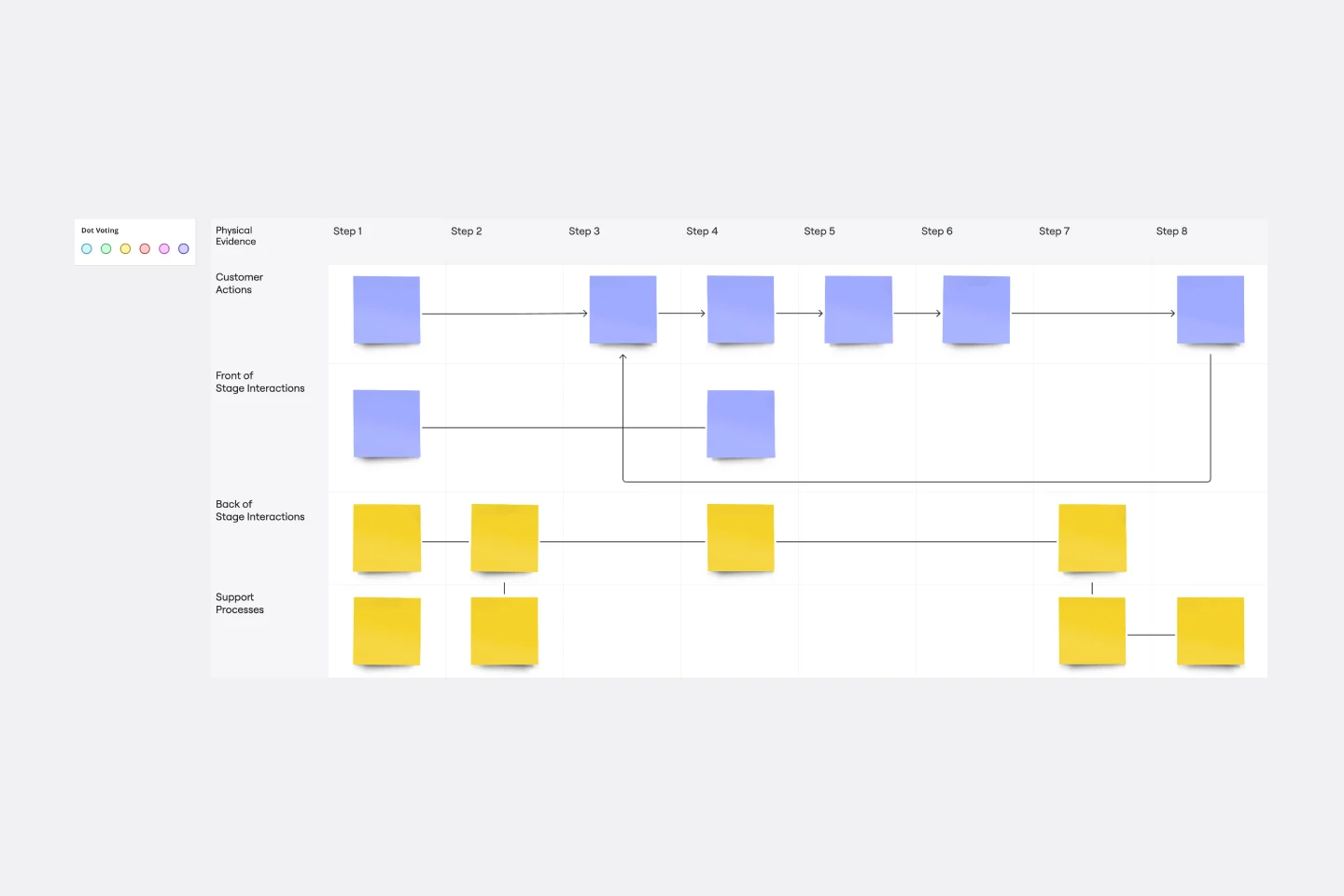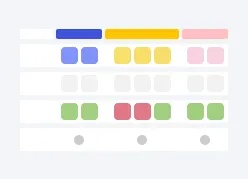About the Customer Touchpoint Map Template
The customer touchpoint map template is a tool that helps you define your customer journey map. UX designers, researchers, and marketers can use this template to identify all the customer touchpoints of your product or brand, flagging which ones are in good order and which ones need improvement.
What is a customer touchpoint map?
A customer touchpoint map is where you can map all your customer’s interactions and touchpoints with your brand or product. It’s a practical and efficient way to see the whole journey, including what needs improvement and what’s been working well.
The customer touchpoint map helps you bring more detail to your customer journey map, where you go more in-depth on how your customer thinks and feels about your brand throughout their journey. A basic CJM includes a specific persona, the steps beginning-to-end of the customer experience, and the potential emotional highs and lows. Both templates are complementary.
Benefits of using a customer touchpoint map
Many teams can benefit from the customer touchpoint map, including designers, developers, and business managers. Here are a few things that will you find out when you build your own customer touchpoint map:
Anticipate multiple customer pathways
Each customer won’t have an identical user journey, so one of the advantages of customer touchpoint mapping is that you can plot out multiple pathways through your product.
By understanding the different ways customers can discover and use your product, you can better anticipate their priorities and what causes churn.
Understand the customer’s perspective
One of the major reasons businesses use customer touchpoint maps is to get a more incisive understanding of how the customer experiences their product. Mapping out customer journeys helps explain why customers make the choices they do and what is most aspect of your product is most valuable to them.
Inform updates and new features
Anytime you want to update your product or add new features, you’ll want to bring in the customer’s perspective. By helping you hone in on the steps and features that are most important to a customer, you can better understand which updates will benefit them the most.
Target customer personas more closely
Customer touchpoint mapping gives you a better understanding of your different buyer personas. Armed with this understanding, you can create different pathways for different personas and provide a more personalized experience.
Improve customer service
Finally, by helping you understand customer needs, customer touchpoint mapping will help you identify at which points in the journey customers need the most help and then target your customer support efforts towards those parts.
When to use the customer touchpoint map template
Customer touchpoint maps are most commonly used by businesses to understand the customer’s actions better, but there are numerous situations when customer touchpoint mapping can be useful.
Visualize the customer experience
Customer touchpoint maps help businesses visualize the customer journey and understand the steps a customer takes through the product. It also allows you to focus on your customer's journey's most influential channels and touchpoints.
Once you can see all phases, you can see where you’re failing to meet their expectations and make improvements to build a better user experience.
Solve a specific problem
Many teams use customer touchpoint mapping as a tool to solve a specific problem. For example, if you’re experiencing churn, it can help you see where your customer might encounter a roadblock that drives them to part ways with your brand.
Improve mission alignment
Suppose you’re having a hard time aligning cross-functionally. In that case, it can be useful to get the teams together to collaborate on creating a customer touchpoint map and ensure you’re putting the customer first.
Create your own customer touchpoint map
Whether you’re a veteran of customer touchpoint mapping or new to the technique, Miro makes it easy to build your own. Get started by selecting the customer touchpoint map template, then take the following steps:
1. Set a timeline
Identify each phase of your customer journey and add it to a linear timeline, including also all your communication channels.
2. Identify each customer touchpoint as an end-to-end journey
Add each customer's interaction with your brand, product, or service. A good way to organize the touchpoints is to think about the buying phases: before, purchase, and after purchase.
3. Analyze the interactions
Write down the positive and negative aspects of each touchpoint, according to your customer’s point of view.
What about your product exceeded your customer’s expectations? Where did it fall short?
4. Iterate and improve
After setting up your customer touchpoint map, see how it helps you develop your customer journey map. As your product and brand evolve, you can continuously iterate and improve your customer touchpoint map as you see fit.
Discover more customer journey map examples to inspire your team.
Customer Touchpoint Mapping FAQs
What’s the difference between a customer touchpoint map and a journey map?
The customer touchpoint map gathers information about the channels you communicate, your customer needs when in contact with your product or brand, and your buying phases. The customer touchpoint mapping can be helpful when building a customer journey map, which gives you a greater overview of your customer’s pain points experiences and a detailed description of their personas.

Miro
Your virtual workspace for innovation
Miro is an innovation workspace designed for teams of every size, everywhere, to dream, design, and build the future together. Our mission? To empower these teams to create the next big thing, powered by AI at every step of the way. Over 90 million users around the world rely on Miro to untangle complex ideas, put customer needs first, and deliver products and services faster. All supported by best-in-class security, compliance, and scalability.
Categories
Similar templates
Customer Journey Map
User Persona Template

User Persona Template
A user persona is a tool for representing and summarizing a target audience for your product or service that you have researched or observed. Whether you’re in content marketing, product marketing, design, or sales, you operate with a target in mind. Maybe it’s your customer or prospect. Maybe it’s someone who will benefit from your product or service. Usually, it’s a whole collection of personalities and needs that intersect in interesting ways. By distilling your knowledge about a user, you create a model for the person you hope to target: this is a persona.
Service Blueprint Template

Service Blueprint Template
The Service Blueprint template is a visual tool for designing and optimizing service experiences. It provides a structured framework for mapping customer journeys, identifying touchpoints, and aligning internal processes. This template enables teams to visualize the entire service ecosystem, uncover pain points, and innovate solutions to enhance customer satisfaction. By promoting customer-centricity and collaboration, the Service Blueprint empowers organizations to deliver exceptional service experiences and drive sustainable growth.
Customer Journey Map
User Persona Template

User Persona Template
A user persona is a tool for representing and summarizing a target audience for your product or service that you have researched or observed. Whether you’re in content marketing, product marketing, design, or sales, you operate with a target in mind. Maybe it’s your customer or prospect. Maybe it’s someone who will benefit from your product or service. Usually, it’s a whole collection of personalities and needs that intersect in interesting ways. By distilling your knowledge about a user, you create a model for the person you hope to target: this is a persona.
Service Blueprint Template

Service Blueprint Template
The Service Blueprint template is a visual tool for designing and optimizing service experiences. It provides a structured framework for mapping customer journeys, identifying touchpoints, and aligning internal processes. This template enables teams to visualize the entire service ecosystem, uncover pain points, and innovate solutions to enhance customer satisfaction. By promoting customer-centricity and collaboration, the Service Blueprint empowers organizations to deliver exceptional service experiences and drive sustainable growth.
